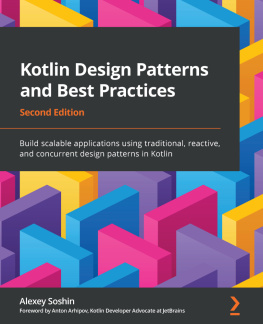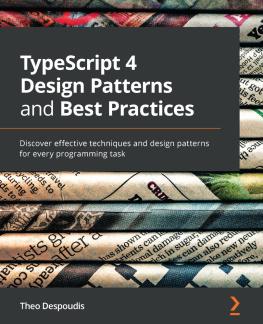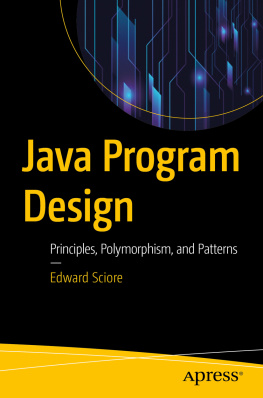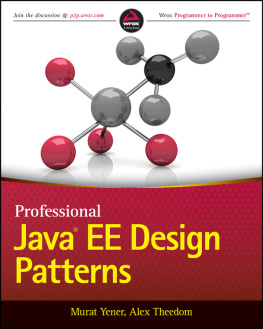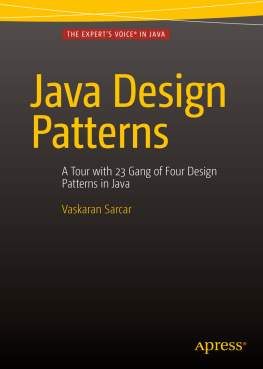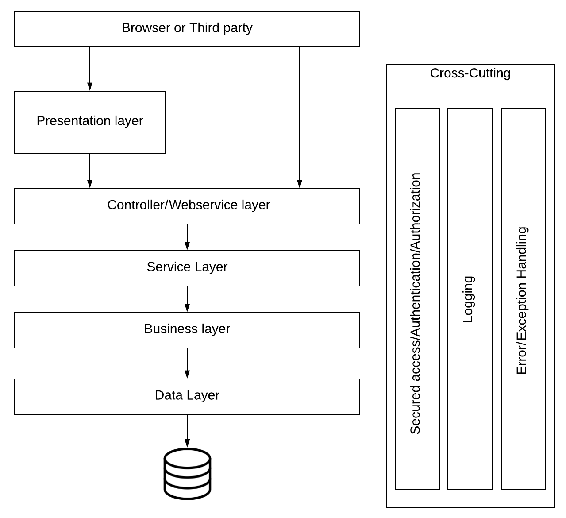Lucian-Paul Torje - Design Patterns and Best Practices in Java
Here you can read online Lucian-Paul Torje - Design Patterns and Best Practices in Java full text of the book (entire story) in english for free. Download pdf and epub, get meaning, cover and reviews about this ebook. year: 2018, publisher: Packt Publishing, genre: Computer. Description of the work, (preface) as well as reviews are available. Best literature library LitArk.com created for fans of good reading and offers a wide selection of genres:
Romance novel
Science fiction
Adventure
Detective
Science
History
Home and family
Prose
Art
Politics
Computer
Non-fiction
Religion
Business
Children
Humor
Choose a favorite category and find really read worthwhile books. Enjoy immersion in the world of imagination, feel the emotions of the characters or learn something new for yourself, make an fascinating discovery.
- Book:Design Patterns and Best Practices in Java
- Author:
- Publisher:Packt Publishing
- Genre:
- Year:2018
- Rating:5 / 5
- Favourites:Add to favourites
- Your mark:
Design Patterns and Best Practices in Java: summary, description and annotation
We offer to read an annotation, description, summary or preface (depends on what the author of the book "Design Patterns and Best Practices in Java" wrote himself). If you haven't found the necessary information about the book — write in the comments, we will try to find it.
Create various design patterns to master the art of solving problems using Java
About This Book- This book demonstrates the shift from OOP to functional programming and covers reactive and functional patterns in a clear and step-by-step manner
- All the design patterns come with a practical use case as part of the explanation, which will improve your productivity
- Tackle all kinds of performance-related issues and streamline your development
This book is for those who are familiar with Java development and want to be in the drivers seat when it comes to modern development techniques. Basic OOP Java programming experience and elementary familiarity with Java is expected.
What You Will Learn- Understand the OOP and FP paradigms
- Explore the traditional Java design patterns
- Get to know the new functional features of Java
- See how design patterns are changed and affected by the new features
- Discover what reactive programming is and why is it the natural augmentation of FP
- Work with reactive design patterns and find the best ways to solve common problems using them
- See the latest trends in architecture and the shift from MVC to serverless applications
- Use best practices when working with the new features
Having a knowledge of design patterns enables you, as a developer, to improve your code base, promote code reuse, and make the architecture more robust. As languages evolve, new features take time to fully understand before they are adopted en masse. The mission of this book is to ease the adoption of the latest trends and provide good practices for programmers.
We focus on showing you the practical aspects of smarter coding in Java. Well start off by going over object-oriented (OOP) and functional programming (FP) paradigms, moving on to describe the most frequently used design patterns in their classical format and explain how Javas functional programming features are changing them.
You will learn to enhance implementations by mixing OOP and FP, and finally get to know about the reactive programming model, where FP and OOP are used in conjunction with a view to writing better code. Gradually, the book will show you the latest trends in architecture, moving from MVC to microservices and serverless architecture. We will finish off by highlighting the new Java features and best practices. By the end of the book, you will be able to efficiently address common problems faced while developing applications and be comfortable working on scalable and maintainable projects of any size.
Style and approachThis book explains design patterns in a step-by-step manner with clear and concise code explanations.
Downloading the example code for this book You can download the example code files for all Packt books you have purchased from your account at http://www.PacktPub.com. If you purchased this book elsewhere, you can visit http://www.PacktPub.com/support and register to have the files e-mailed directly to you.
Lucian-Paul Torje: author's other books
Who wrote Design Patterns and Best Practices in Java? Find out the surname, the name of the author of the book and a list of all author's works by series.


